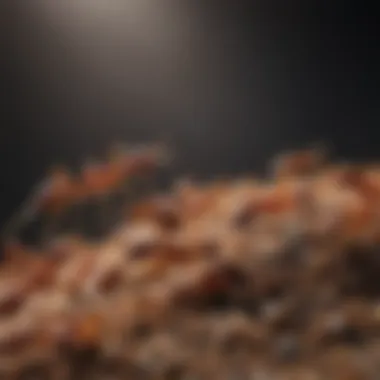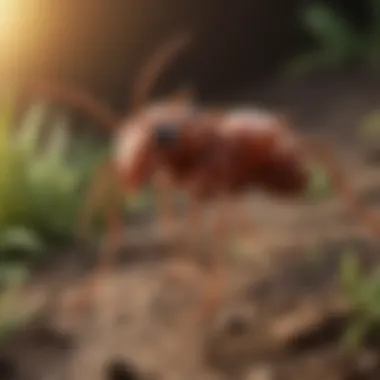Effective Fire Ant Control Strategies for Texas Residents


Preventive Pest Control Strategies
Effective pest control begins long before notcieable pests invade your olant and home, especially when tackling notorious problems like fire ants. Implementing preventive pest control strategies can diminish the chance of an infestation. A thorough understanding of your immediate environment, how pests enter, and what attracts them singificantly contributes to minimizing risk. Below are some ways to establish a pest-safe home.
House Exterior Protection
Tips for sealing cracks
Inspect your home's exterior for any openings or cracks, as these serve as points of entry for pests. Applying caulk to seal gaps around windows and doors and energy-efficient door sweeps can be effective. Use a light to help inspect smaller holes and tiny gaps, particularly near utility lines.
Clearing debris
Too much clutter or debris around the house can invite pests to make their homes near yours. Regularly clear leaves, paper, mulch, and dense vegetation close to the foundation. This not only reduces attractors but makes inspections for other signs of pests eaiser.
Preventing pests from entering
Make sure window screens are intact and utilized across operating windows. Keep exterior doors closed and check for the presence of utility conduits which can function as entrance points. Installing thresholds can assist with keeping unwated creatures from coming inside.
Yard Maintenance
Essential yard care routines
Maintain consistent yard care routines to promote thick grass growth, as dense lawns deter fire ants. Mow regularly and establish edged plant beds which mitigate environmental conditioning that these pests prefer.
Methods for keeping yard pest-free
Essential maintenance touches on early identification of pest infestations. Keep or improve topsoil drainage to eradicate damp conditions that encourage pest nesting.-es
Indoor Cleanliness
Expert cleaning tips and techniques
Interior cleanliness plays a vital role. Regular vacuuming and wiping up spilled foods and liquids prevents food sources accessible to ants and other insects. Small crumbles are often an inviting feast.
Maintaining a pest-resistant indoor environment
Store pantry items in airtight containers. This reduces attraction. Paper and cardboard are easily damaged and compromise the integrity of the harvested food.
Garbage Disposal
Efficient waste disposal methods
An effective garlic prevention plan that most often get forgoten pertains to solid waste management. Make sure all rubbish insinde and outside is discared properly and quickly.
Importance of proper garbage disposal
Having tight caps on all waste cuddies is crucial. Pests an smell food easily, which escalates attraction and involvement thereathtaking your revamped safety control.
Other Pest Prevention Strategies
Innovative ways to safeguard your home
Ever consider planting pest-repelling culubiate distanceary employ[,] garlic or auditory which repel common interested leavings notizcapitalize outdated techniques implemented and degrade dorirmeneensfend at landmarbes research.
A systematic approach will benefit the backyard while decreasing possibilities of increasing pest probability assessments.
Intro to Texas Fire Ants
Understanding Texas fire ants is crucial for effective management and control measures. These invasive species impact both residents and wildlife, leading to considerable ecological and economic challenges. Texas is particularly susceptible to fire ant infestation due to its climate and suitable habitats. Therefore, addressing this issue is vital for maintaining both comfort and health in the community.
Overview of Fire Ant Species
Texas is primarily home to two fire ant species: the Red Imported Fire Ant and the Native Texas Fire Ant.


- Red Imported Fire Ant: This species was first identified in the U.S. in the 1930s, originally from South America. It has spreading aggressively across the southern states, especially Texas. Known for their aggressive nature and painful sting, these ants can form large colonies with thousands of individual workers. The health impact from their stings can be significant, especially for allergic individuals.
- Native Texas Fire Ant: Predominantly found in the eastern parts of Texas, this species is less aggressive compared to its invasive counterparts but still presents other issues, such as disruption to local ecosystems.
Understanding these species helps in choosing the proper control methods and understanding their behavior in different environments.
Geographical Distribution in Texas
Fire ants thrive in many areas across Texas. However, their population density varies by region. They are predominantly found in:
- Urban Areas: Cities such as Houston and Dallas often have significant populations due to disturbed soil and abundant food sources.
- Grasslands: Texas localities with open fields and pastures support their colonies well, making infestations common in country areas.
- Parks and Recreational Areas: These ants exploit habitats where people congregate, posing risks to both human comfort and outdoor activities.
Their presence shows different ecological footprints depending on the area. In ecosystems with a strong fire ant presence, effects on native wildlife and habitats can be far-reaching. Therefore, recognizing the distribution of fire ants across Texas becomes a requisite for any successful control strategy.
Biology and Behavior of Fire Ants
Understanding the biology and behavior of Texas fire ants is crucial for effective control strategies. These aspects influence how fire ants interact with their environment and respond to different management approaches. The insight garnered from studying their life cycle, social structure, and feeding habits not only assists in developing targeted control methods but also predicts potential infestations.
Life Cycle Stages
Texas fire ants undergo several distinct stages in their life cycle: egg, larva, pupa, and adult. Each stage presents unique vulnerabilities for control efforts.
- Egg Stage: Eggs are small, white, and difficult see. They hatch into larvae within a few days. At this point, they can be targeted using specific types of insecticides that disrupt their growth.
- Larval Stage: Larvae depend on worker ants for food and care. Their exposed nature means this stage is susceptible to certain baiting techniques. As they grow, so does their impact on the colony's expansion.
- Pupal Stage: In this cocoon-like state, they metamorphose into adults. Special treatments, such as heat applications, can disrupt their development during this phase.
- Adult Stage: Adults exhibit reproductive casting and foraging roles. Understanding their behavior at this stage allows for more tailored control efforts, such as targeted baiting.
This cyclicity enables ongoing opportunities to inhibit population growth.
Colony Structure and Roles
Texas fire ant colonies exhibit a structured hierarchy comprising different castes, primarily workers, queens, and males.
- Queens: The reproductive individuals ensure the ongoing survival of the colony. A single colony can have multiple queens, increasing its capability for expansion.
- Workers: These ants perform daily tasks, like foraging, caring for the young, and maintaining the nest. Their role is crucial for the navigation of the colony's interactions with the environment. Pest control interventions focusing on worker foragers can drastically affect colony viability.
- Males: There are fewer males in a colony, primarily existing for mating purposes. Once the mating feast is concluded, males typically die shortly after.
The social structure requires coordinated behavior critical to the survival of the colony. Understanding this organization helps to exploit the weaknesses of specific roles in pest control measures.
Feeding Habits
Fire ants are opportunistic feeders, exhibiting flexibility in their diet by consuming various sources of nourishment. Key components of their diet include:
- Sugar-rich substances: These are essential for energy requirements. They commonly gather nectar from plants and will exploit sugary food residues around residential areas.
- Protein sources: Protein is vital for their growth, particularly larvae. They can hunt other insects, or gather organic waste. Their protein needs transform seasonally, showing adaptability in hunting patterns based on prey availability.
Through appropriate bait placement focusing on these dietary preferences, residents can discourage foraging, reducing the number of forager workers returning to the colony. Effective feeding response serves imperatively when devising intervention strategies.
Fire ants demonstrate intriguing adaptability that threatens various local ecosystems and suburban areas in Texas.
Utilizing knowledge of biology and behavior can amplify efforts achieving a manageable environment free from fire ant infestations.
Impact of Fire Ants on the Ecosystem
The presence of fire ants in Texas greatly influences local ecosystems. Understanding these impacts is crucial for homeowners and gardeners who want to manage their outdoor spaces effectively. Fire ants can alter soil structure, compete with native species, and affect agricultural productivity. Their multifaceted role demands thorough research to develop improved management solutions that protect native wildlife while preserving agricultural interests.
Effects on Native Wildlife
Fire ants occupy a complex role within Texas ecosystems. They attract some species but threaten native wildlife. Their aggressive nature impacts birds, small mammals, and other insects. For example, birds like ground-nesting species may lose young from ant attacks. Small mammals also face increased predation risks when fire ants invade their burrows. Local ecosystems are interrupted as fire ants push out rival species for resources. Environmental balance can shift, sometimes allowing pests to thrive in overabundance.
The threat to native species due to fire ants highlights a critical need for awareness and control measures.
Economic Impact on Agriculture
Fire ants can significantly drain agricultural resources in Texas. Many crops, like cotton and corn, face damage from fire ant colonies. They damage germinating seeds while reducing overall crop yields. Additionally, managing fire ants drives up costs. Farmers may spend considerable amounts on control measures such as chemical treatments or baiting products. In severe instances, entire fields may become unmanageable, leading to serious economic losses.
Health Risks to Humans and Pets
Fire ants pose health risks for humans and pets. Their powerful stings can cause serious allergic reactions. Initial symptoms often include intense localized pain, itching, and swelling. For some, a sting may trigger more severe allergic responses, leading to anaphylaxis. Pets can also be targets of fire ant swarming. Various small animals, including dogs and cats, may gain injuries from fire ant attacks. Understanding these risks is crucial for fostering safe outdoor environments for families and pets alike. Consequently, careful monitoring and decisive action are necessary to mitigate these threats.
Methods of Fire Ant Control


Fire ants present a significant challenge to homeowners and professionals in Texas. Effective control methods are essential to minimize their impact on local ecosystems and property. This section examines various methods of fire ant control, highlighting different chemical and non-chemical strategies that can be employed.
Chemical Control Options
Chemical control remains one of the most prevalent options for managing fire ant infestations. Although chemical methods can provide quick results, they must be applied judiciously to ensure safety and effectiveness.
Granular Insecticides
Granular insecticides are popular among homeowners for controlling fire ants, primarily because of their ease of application. These products are often broadcast over soil surfaces, where they settle into the ground and are attractive to foraging ants. The key characteristic of these insecticides is their effectiveness in targeting the entire colony when the worker ants take the bait back to their nest.
A unique feature of granular formulations is that they can be applied at different times of the year, which provides flexibility in how and when they are used. However, one disadvantage is that environmental conditions, such as rain or irrigation, can affect their performance, potentially washing them away before they are ingested by the ants.
Liquid Insecticides
Liquid insecticides are another effective tool, particularly for spot treatments. These solutions can penetrate deep into the soil, making targeting fire ants even easier. Their main advantage lies in their quick action, with many formulations capable of killing the ants within hours. This property makes them preferable when dealing with dense infestations in small areas.
One downside, however, is the need for careful application to avoid adverse impacts on beneficial insects. Liquid treatments also tend to require more equipment and expertise, which may be a limiting factor for some homeowners.
Professional Pest Control Services
For extensive fire ant infestations, professional pest control services may be the most comprehensive solution. Trained professionals have access to specialized formulations and techniques that are typically not available to consumers. The key characteristic of these services is their systematic approach to not only eradicate visible ants but also to implement a long-term management plan for prevention.
While this approach can assure efficacy, it's often more expensive than DIY methods. Homeowners must weigh the benefits against the cost, as well as evaluate the choice of service providers to ensure responsible use of chemicals.
Non-Chemical Control Strategies
In recent years, there has been a growing interest in non-chemical control strategies. These methods can be integrated into comprehensive control plans, and they often emphasize environmental responsibility.
Baiting Techniques
Baiting techniques utilize attractants to lure fire ants to a poison food source. This slow-kill method allows foraging ants to carry the bait back to the colony, ultimately affecting a majority of the ants, including the queen.
The distinct feature of baiting is its low environmental impact compared to chemical sprays. However, timing is critical, as ants must be actively foraging for the bait to be effective. A disadvantage is that bait efficiency can vary based on the type of bait used and seasonal activity patterns.
Boiling Water Method
The boiling water method presents a straightforward and accessible approach for managing isolated mounds. Pouring hot water directly onto the nest can kill a considerable number of ants quickly. One of its primary benefits is simplicity neither chemicals nor expensive tools are needed.
A significant drawback is its limited effectiveness, especially with larger mounds. Often, not all ants are killed, and the colony can recover. It is more practical in conjunction with other methods rather than a standalone solution.
Nematode Application
Using nematodes for fire ant control represents an innovative biological method. Nematodes are microscopic roundworms that invade and kill fire ants when applied to the affected areas. This eco-friendly approach is prized for its minimal environmental impact.
Despite its promise, there are some considerations to bear in mind. Nematode treatments are best used under suitable conditions, as soil temperature and moisture levels must be optimized for success. Additionally, skill and knowledge are needed in their application to ensure effectiveness.
Sustainable fire ant management requires a blend of methods tailored to specific circumstances and desired outcomes.
Preventive Measures for Fire Ant Infestation
Preventive measures play a crucial role in managing fire ant populations in Texas. They not only reduce the likelihood of infestation, but they also minimize the costs associated with eradication efforts. By employing strategic practices, homeowners can create an inhospitable environment for fire ants, thereby decreasing their numbers naturally.
Cultural Practices
Yard Maintenance
Yard maintenance refers to the consistent care and upkeep of landscapes to deter fire ants. This practice is significant because regularly maintaining one’s yard can significantly reduce potential nesting areas. Keeping grass mowed to a proper height and removing debris helps eliminate the shelter they seek. A tidy yard can make a not-so -welcoming spot for fire ants.
The key characteristic of yard maintenance lies in its simplicity and low cost. It is an easy, proactive measure that fits naturally with the lifestyle of the homeowner. The unique feature of this approach is that it works in harmony with nature to create less attractive habitats.
However, yard maintenance also requires regular effort. Some people may find it tedious. Moreover, if maintenance is neglected, fire ants may still thrive in overgrown and cluttered areas, undermining this strategy’s effectiveness.
Proper Waste Management


Proper waste management is another aspect vital to preventing fire ant infestations. Disposing of garbage correctly removes sources of sustenance for fire ants. Scraps in garbage bags can attract them, as can neglected compost piles. Ensuring that trash is properly sealed helps to cut off their food sources.
A standout feature of proper waste management is its integral connection to overall hygiene in the home environment. This makes it a beneficial choice for households looking to maintain cleanliness. Waste management requires a small change in daily habits that yields long-term benefits in controlling pests.
Nevertheless, those living in areas where bulk trash is set out may find more difficult situations arise— such as vulnerable trash piles left for extended periods before collection. Quick solutions might not always be available, making consistent waste management a challenging task for some individuals.
Landscape Design Considerations
Native Plant Selection
Native plant selection is essential for reducing fire ant populations. Using plants that are native to Texas means fostering a landscape that requires less maintenance, water, and chemical inputs. When landscapes are naturally appealing to local wildlife and less pleasing to invasive species such as fire ants, the natural balance is encouraged while superficial visual appeal is achieved.
The key advantage of this practice is that these plants thrive in regional soil and climate conditions, leading to healthy and sustainable landscaping solutions. Focusing on native species helps deter pest populations, as fire ants are more likely to nest in non-native settings.
However, a potential issue with this approach may lie in the initial transition effects. Homeowners may not see instant results, and certain native plants can take longer to establish.
Avoiding Mulch Material Attraction
Avoiding mulch material that can attract fire ants significantly enhances effective management strategies. Certain types of mulch, such as cypress or pine bark, may harbor excess moisture or offer ideal nesting conditions for fire ants. Therefore, it is wise to choose mulch types which do not appeal to these insects.
This preventive measure effectively reduces the spots where fire ants tend to nest while promoting any landscaping project that conserves moisture at the same time. A key attribute is its integration into designing the landscape with biodiversity in mind, improving both the environments while reducing the risk of fire ant infiltration.
However, sourcing suitable mulch can sometimes be difficult. Moreover, some alternatives may be pricier, which creates a barrier for frugal landscapers.
Consider combining preventative measures for maximum effectiveness. An integrated approach addressing multiple factors can lead to solid results over time.
Evaluating the Effectiveness of Control Methods
Evaluating the effectiveness of fire ant control methods is crucial for any practical approach to managing infestations in Texas. Proper evaluation helps determine whether the chosen method achieves its targets while minimizing any potential hazards. Assessing effectiveness contributes significantly to long-term management strategies. Côte out effective methods gives homeowners peace of mind while ensuring their properties are protected from the pervasive impact of fire ants.
Monitoring for Fire Ant Activity
Monitoring is a critical first step in evaluating fire ant control. Homeowners should consistently lookout for signs of activity. This vigilance includes identifying active mounds or spotting ants foraging for food. Noting such behaviors can indicate the effectiveness of recent control measures.
Several techniques assist in monitoring effectiveness:
- Regular Inspections: Break down your yard into sections and periodically check each one for nests. Finding new mounds indicates a need for reevaluation.
- Bait Traps: Use bait stations to monitor ant activities. These traps help in gauging where ants are actively feeding.
- Soil Disturbance Checks: Assess any disturbances around identified mounds. A healthy colony will show some soil disruption.
By establishing clear benchmarks for ant activity, homeowners can observe changes over time, allowing them to make informed decisions on further action.
Assessing Control Success
A straightforward assessment allows one to measure outcomes quantitatively or qualitatively. Success evaluation goes beyond merely detecting ants or nests but also involves understanding the impact of chosen methods on fire ant populations and associated changes to the yard environment.
When evaluating success, consider these factors:
- Reduction in Mound Numbers: A drop in visible mounds compared to initial counts can indicate successful intervention.
- Behavior of Remaining Ants: Following application of a control method, observe how any remaining ants behave. Reduced foraging? Less aggression?
- Duration of Control: Stay aware of time frames between treatments and how long control lasts. Lingering effectiveness plays a critical role in ongoing management.
The integration of the aforementioned assessments and monitoring techniques sharpens effective strategies against Texas fire ants. Particularly for homeowners battling these insects in their landscapes, maintaining awareness around these evaluations nurtures a long-term solution plenty of them seek.
Closure and Future Directions in Fire Ant Control
Effectively managing Texas fire ants is crucial for protecting your environment and health. This section consolidates the most effective strategies and sets the groundwork for future research and actions. As fire ant populations continue to grow, understanding their habits and control methods is not just recommended but essential. The conclusion emphasizes the need for both immediate action and long-term strategies to mitigate fire ant infestations.
Summary of Best Practices
Practices in controlling fire ants must be both thorough and adaptable. Below is a collection of the best approaches:
- Regular Monitoring: Keep an eye on your yard for new mounds and early signs of infestation. Catching fire ants early makes control much simpler.
- Integrated Pest Management: Combine chemical and non-chemical methods for comprehensive control. This reduces dependency on harmful products while ensuring effective responses to infestations.
- Targeted Treatment: Use baits specifically designed for fire ants. Granular and liquid options can both be effective. Follow the label instructions closely to maximize effectiveness.
- Maintain Proper Landscape Practices: Regularly mow, prune, and remove debris where ants might nest. Focus on enhancing the growth of native plants that do not attract fire ants.
- Educational Outreach: Participate in or conduct community workshops on fire ant management. Increasing awareness around your neighborhood can lead to better overall suppression of these ants.
Ultimately, a blend of scientific understanding and practical application will serve as the cornerstone of effective fire ant control strategies.
Research Gaps and Opportunities
While significant progress has been made in understanding and managing fire ants, there still lies an array of research opportunities:
- Biological Control Methods: More studies on beneficial nematodes and microbial agents would be invaluable. These approaches promise to lessen chemical use and improve environmental safety.
- Impact of Climate Change: As climates evolve, fire ant behaviors are likely to change. Research linking climate factors to their distribution patterns and lifecycle can provide deeper insights for better management.
- Community-Based Programs: The examination of how local communities manage fire ants differently can reveal effective tactics. Case studies could assist in drawing up regional strategies tailored to specific local needs.
- Public Awareness: Investigating how educational campaigns affect public behavior regarding fire ant management could help optimize control programs.
The journey toward fully understanding and managing fire ants is ongoing. The need to bridge these research gaps will be critical for effective future strategies, not just in Texas but across regions affected by this invasive species.
“Awareness is the first step in effective fire ant management.”



